Data Wrangling - two data frames 🛠
MATH/COSC 3570 Introduction to Data Science
Dr. Cheng-Han Yu
Department of Mathematical and Statistical Sciences
Marquette University
Department of Mathematical and Statistical Sciences
Marquette University
Joining data frames
Joining data frames
Have multiple data frames
Want to bring them together
-
SQL-like functions
left_join(x, y)right_join(x, y)full_join(x, y)inner_join(x, y)semi_join(x, y)anti_join(x, y)
Setup
Data sets x and y share the same variable id.
left_join(x, y): all rows from x
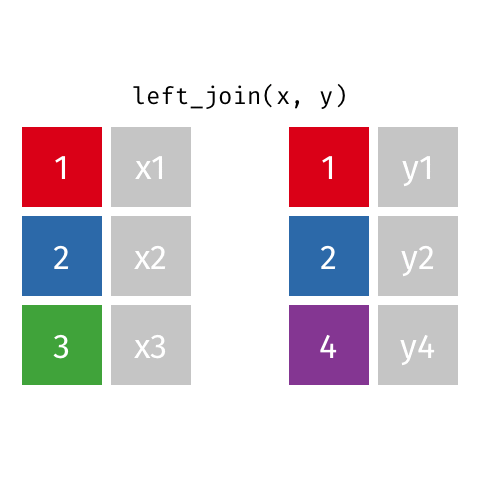
## by = keys
left_join(x, y, by = "id")# A tibble: 3 × 3
id var_x var_y
<chr> <chr> <chr>
1 01 x1 y1
2 02 x2 y2
3 03 x3 <NA> -
NAis added to theidnot appearing iny.

left_join() Example
pop_x state population
1 Alabama 4779736
2 Alaska 710231
3 Arizona 6392017
4 Arkansas 2915918
5 California 37253956
6 Colorado 5029196elec_vote_y state elec_vote
1 California 55
2 Arizona 11
3 Alabama 9
4 Connecticut 7
5 Alaska 3
6 Delaware 3pop_x |>
left_join(elec_vote_y) #<< state population elec_vote
1 Alabama 4779736 9
2 Alaska 710231 3
3 Arizona 6392017 11
4 Arkansas 2915918 NA
5 California 37253956 55
6 Colorado 5029196 NA-
ConnecticutandDelawareinelec_vote_ywill not be shown in the left-joined data because they are not inpop_x.
library(tidyverse)
library(dslabs)
pop_x <- murders |>
slice(1:6) |>
select(state, population)
elec_vote_y <- results_us_election_2016 |>
filter(state %in% c("Alabama", "Alaska", "Arizona",
"California", "Connecticut", "Delaware")) |>
select(state, electoral_votes) |>
rename(elec_vote = electoral_votes)
right_join(x, y): all rows from y
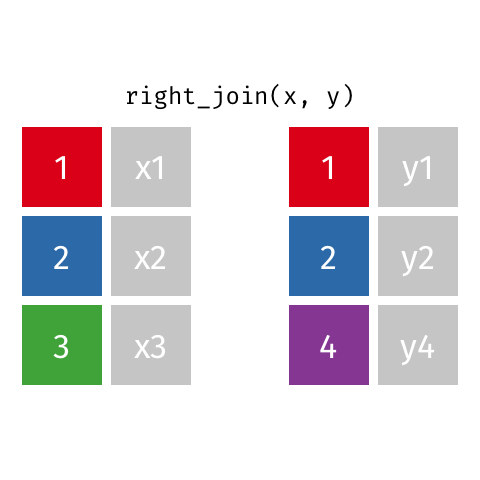
right_join(x, y)Joining with `by = join_by(id)`# A tibble: 3 × 3
id var_x var_y
<chr> <chr> <chr>
1 01 x1 y1
2 02 x2 y2
3 04 <NA> y4 -
NAis in the column coming fromx.
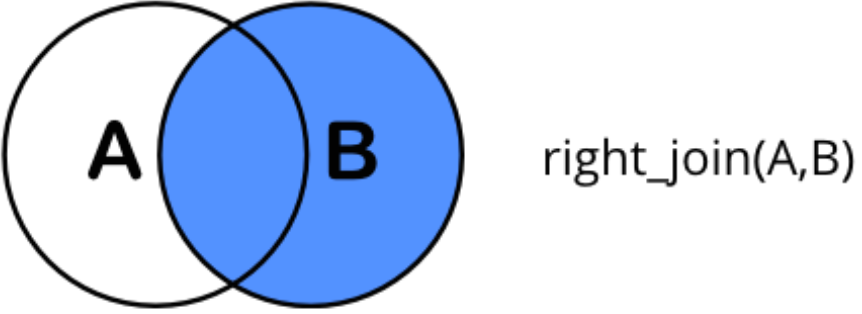
right_join() Example
pop_x state population
1 Alabama 4779736
2 Alaska 710231
3 Arizona 6392017
4 Arkansas 2915918
5 California 37253956
6 Colorado 5029196elec_vote_y state elec_vote
1 California 55
2 Arizona 11
3 Alabama 9
4 Connecticut 7
5 Alaska 3
6 Delaware 3pop_x |>
right_join(elec_vote_y) #<< state population elec_vote
1 Alabama 4779736 9
2 Alaska 710231 3
3 Arizona 6392017 11
4 California 37253956 55
5 Connecticut NA 7
6 Delaware NA 3-
ArkansasandColoradoinpop_xwill not be shown in the right-joined data because they are not inelec_vote_y.
full_join(x, y): all rows from both x and y
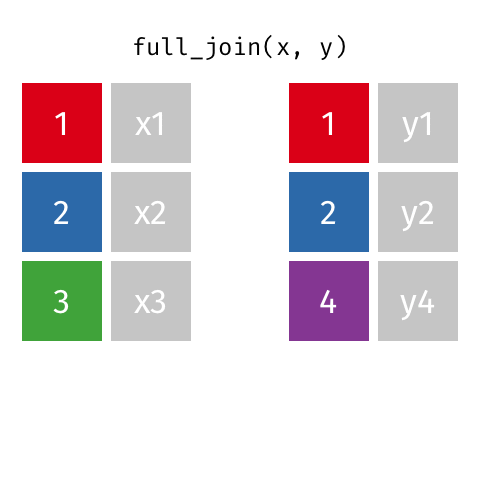
full_join(x, y)Joining with `by = join_by(id)`# A tibble: 4 × 3
id var_x var_y
<chr> <chr> <chr>
1 01 x1 y1
2 02 x2 y2
3 03 x3 <NA>
4 04 <NA> y4 - Keep all the rows and fill the missing parts with
NAs.

full_join() Example
pop_x state population
1 Alabama 4779736
2 Alaska 710231
3 Arizona 6392017
4 Arkansas 2915918
5 California 37253956
6 Colorado 5029196elec_vote_y state elec_vote
1 California 55
2 Arizona 11
3 Alabama 9
4 Connecticut 7
5 Alaska 3
6 Delaware 3pop_x |>
full_join(elec_vote_y) #<< state population elec_vote
1 Alabama 4779736 9
2 Alaska 710231 3
3 Arizona 6392017 11
4 Arkansas 2915918 NA
5 California 37253956 55
6 Colorado 5029196 NA
7 Connecticut NA 7
8 Delaware NA 3-
full_join()takes the union of observations ofxandy, so it produces the data set with the most rows.
inner_join(x, y): only rows w/ keys in both x and y
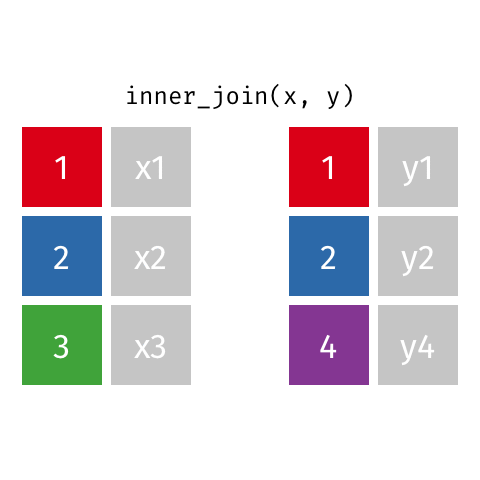
inner_join(x, y)Joining with `by = join_by(id)`# A tibble: 2 × 3
id var_x var_y
<chr> <chr> <chr>
1 01 x1 y1
2 02 x2 y2 - Keep only the rows that have information in both tables.

inner_join() Example
pop_x state population
1 Alabama 4779736
2 Alaska 710231
3 Arizona 6392017
4 Arkansas 2915918
5 California 37253956
6 Colorado 5029196elec_vote_y state elec_vote
1 California 55
2 Arizona 11
3 Alabama 9
4 Connecticut 7
5 Alaska 3
6 Delaware 3pop_x |>
inner_join(elec_vote_y) #<< state population elec_vote
1 Alabama 4779736 9
2 Alaska 710231 3
3 Arizona 6392017 11
4 California 37253956 5516-Joining tables
In lab.qmd ## Lab 16 section
- Import the data at https://www.jaredlander.com/data/DiamondColors.csv. Call it
diamond_color.
diamond_color <- readr::read_csv("the url")- Use
left_join()to combine the data setdiamondsin ggplot2 anddiamond_colorby the key variablecolor.
- Select the variables
carat,color,Description,Details.
- Create a bar chart of the variable
color.
# A tibble: 53,940 × 4
carat color Description Details
<dbl> <chr> <chr> <chr>
1 0.23 E Colorless Minute traces of color
2 0.21 E Colorless Minute traces of color
3 0.23 E Colorless Minute traces of color
4 0.29 I Near Colorless Slightly detectable color
5 0.31 J Near Colorless Slightly detectable color
6 0.24 J Near Colorless Slightly detectable color
# ℹ 53,934 more rows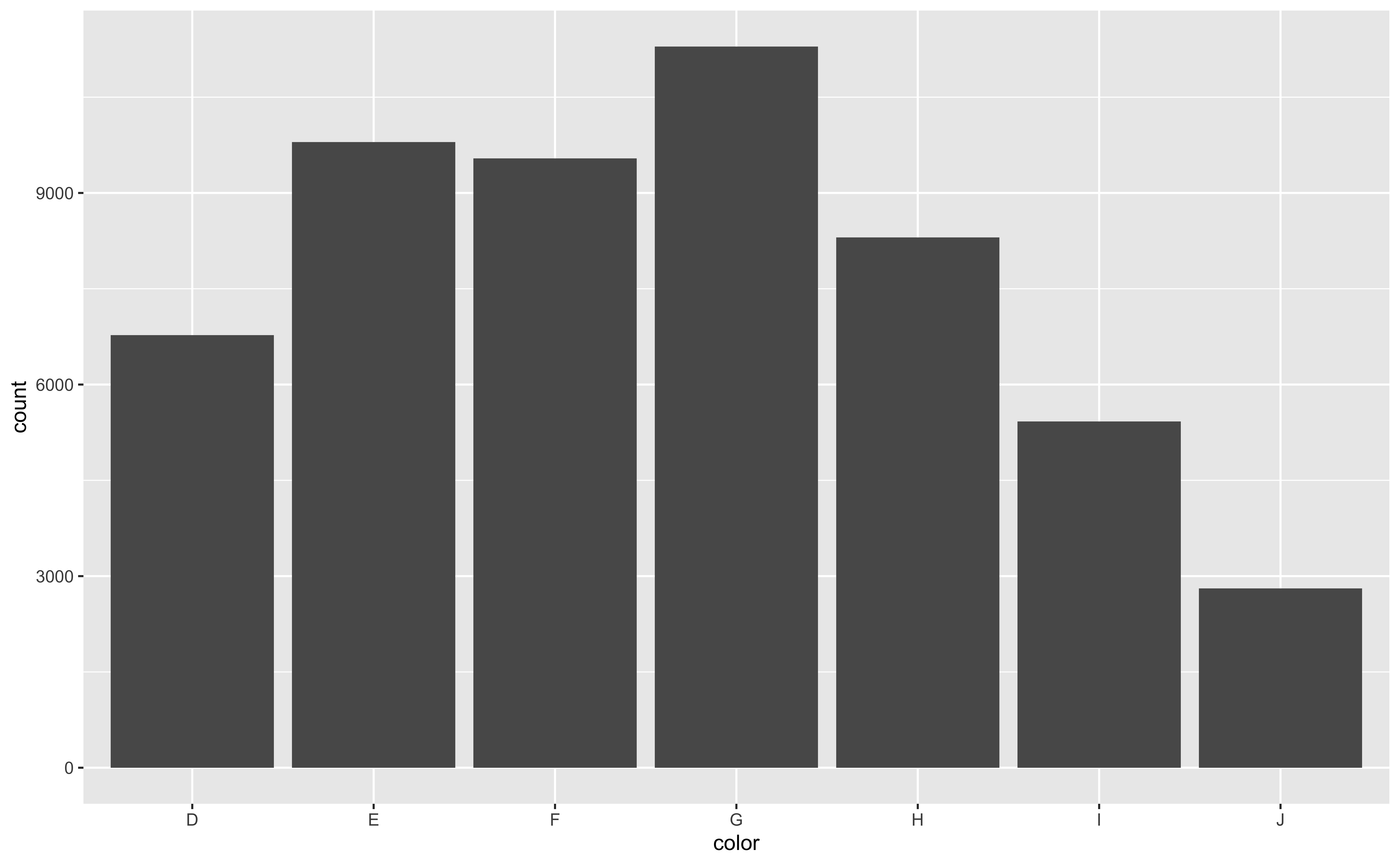
Joining Data Frames
pd.merge()
pd.merge()
murders = pd.read_csv('./data/murders.csv')
pop_x = murders[0:6][['state','population']]
election = pd.read_csv('./data/results_us_election_2016.csv')
raws1 = ["Alabama", "Alaska", "Arizona", "California", "Connecticut", "Delaware"]
cols1 = ["state", "electoral_votes"]
df = election[cols1]
pop = []
for i in raws1:
mask = df["state"] == i
pos = np.flatnonzero(mask)
pop.append(pos)
pop = np.array(pop)
pop = np.resize(pop, 6)
elec_vote_y = df.iloc[pop]